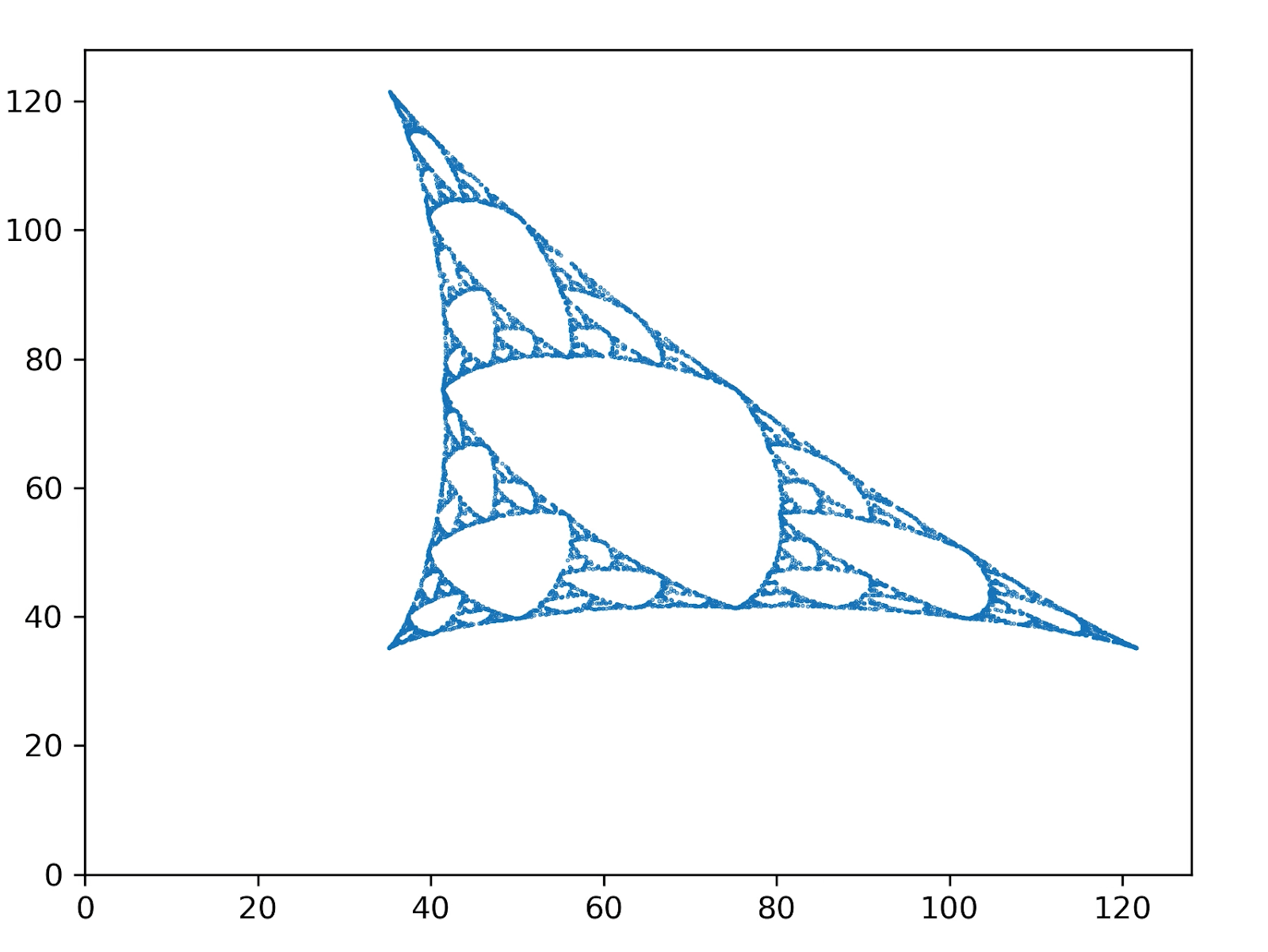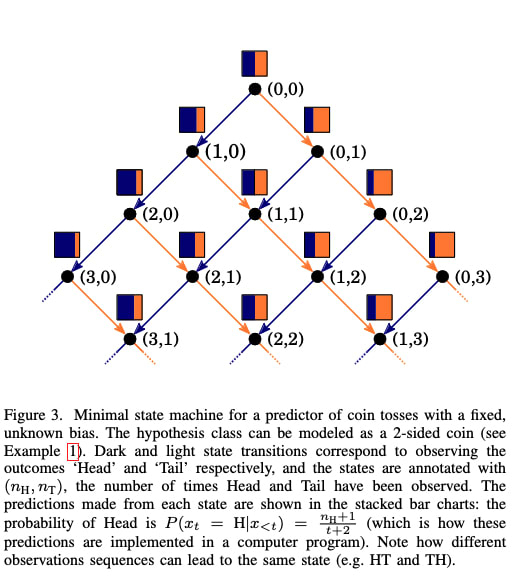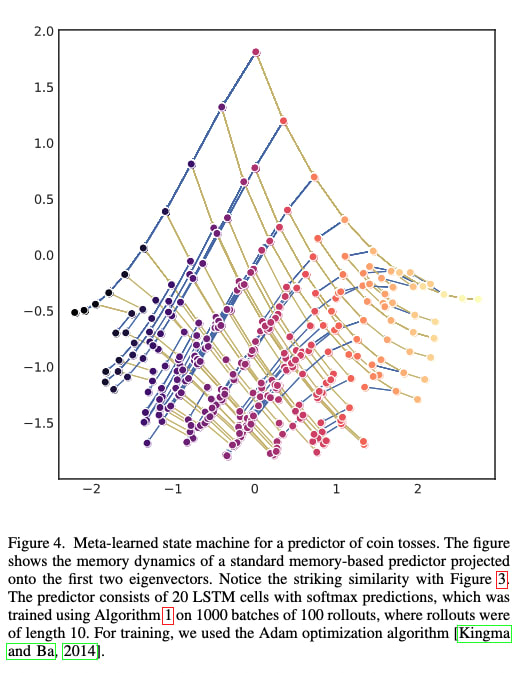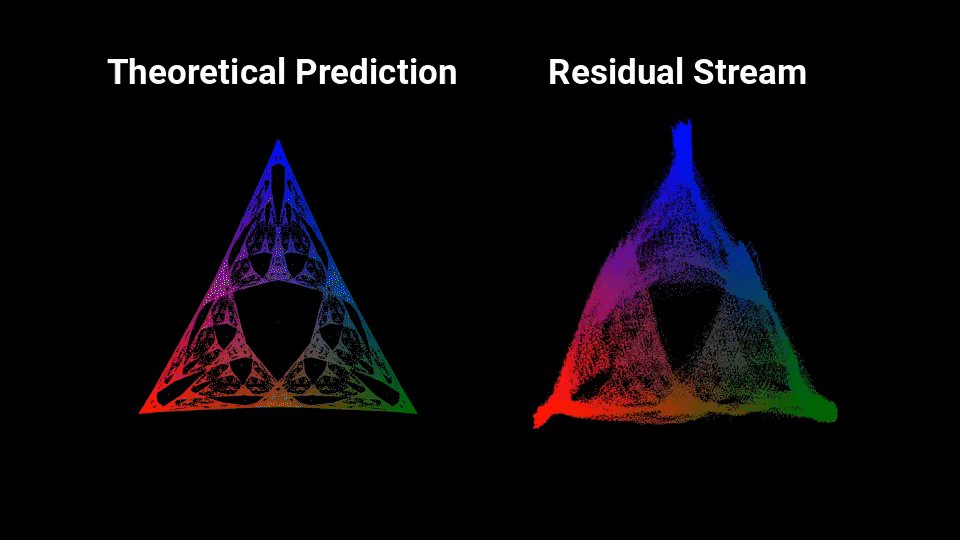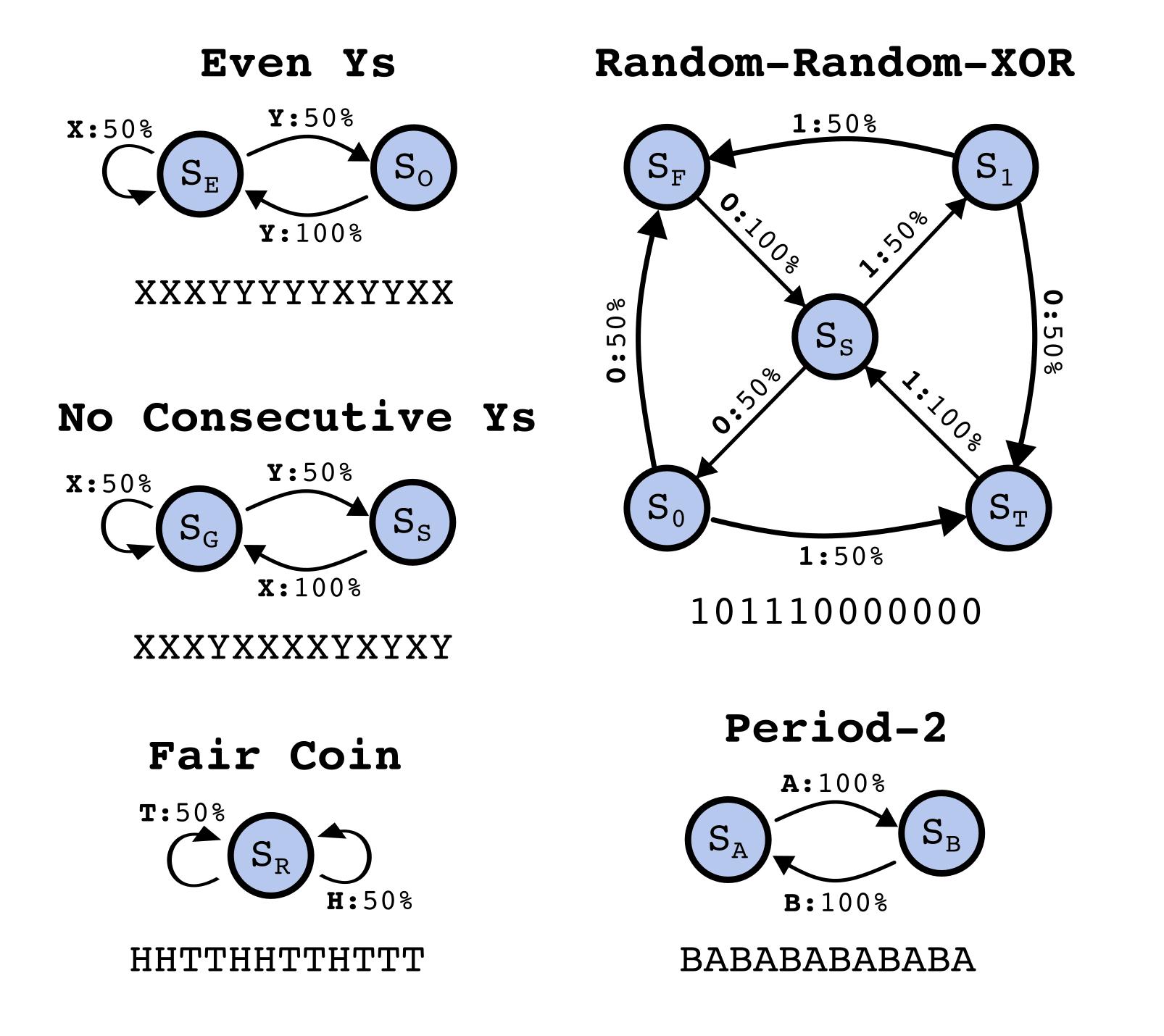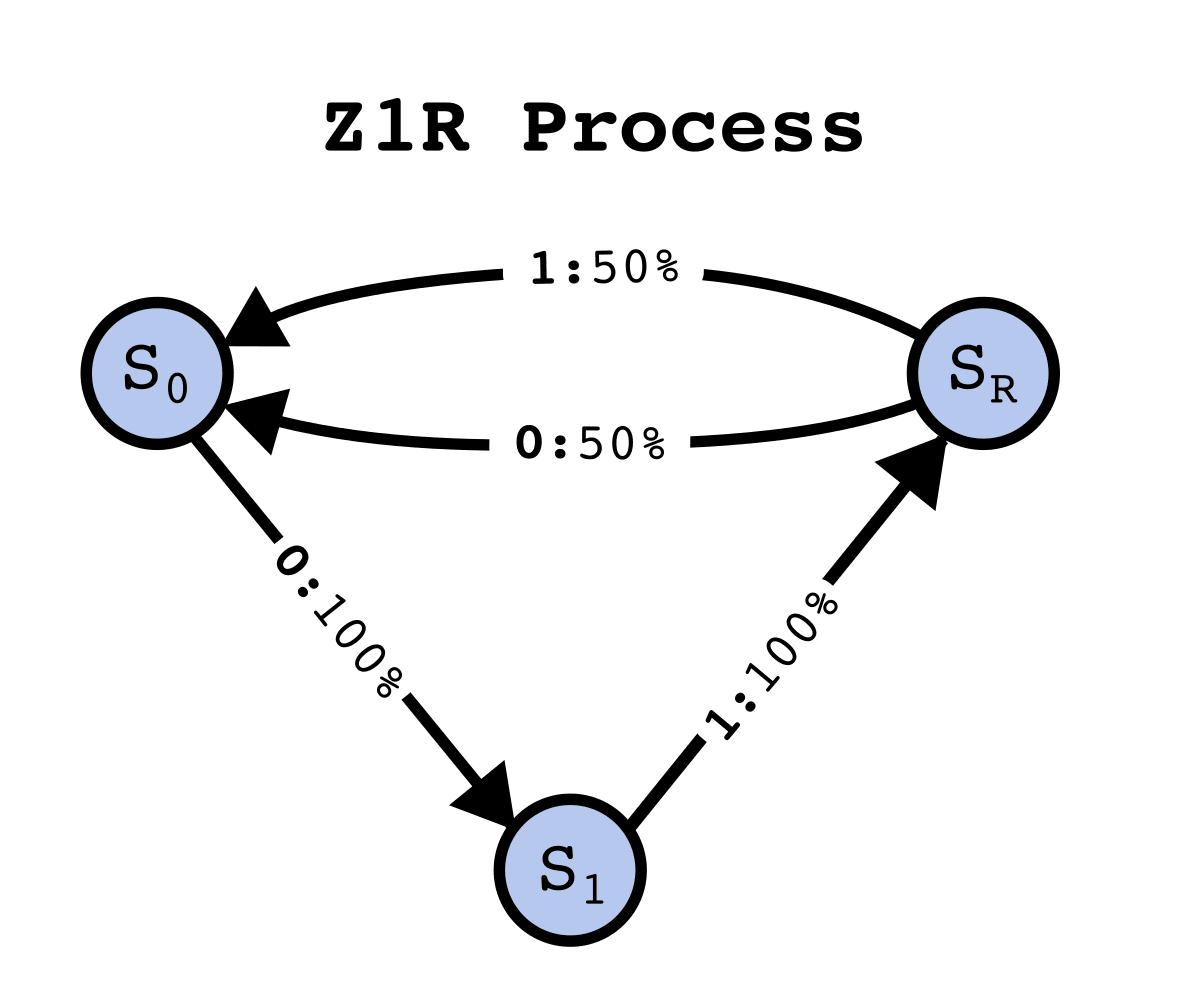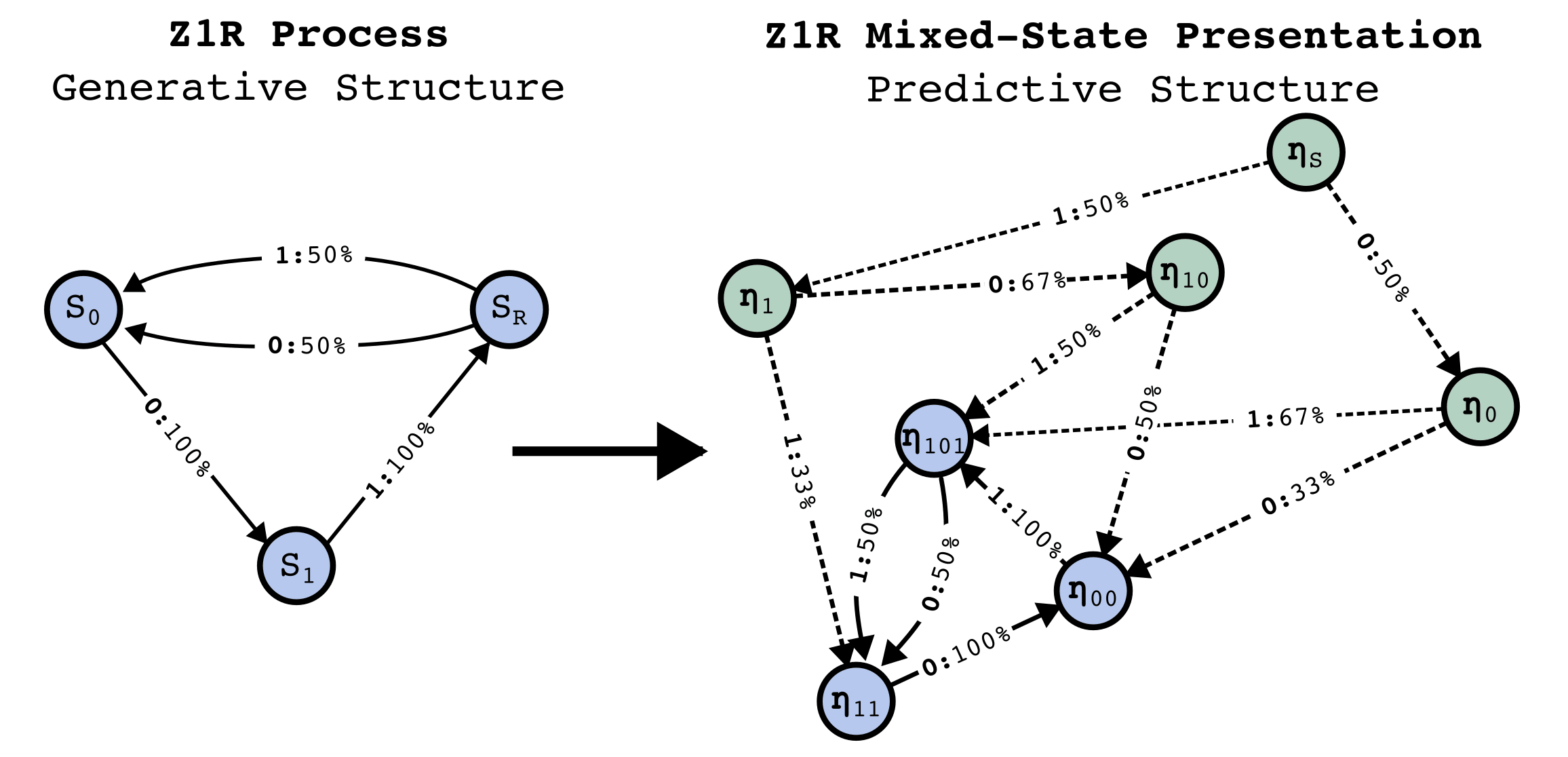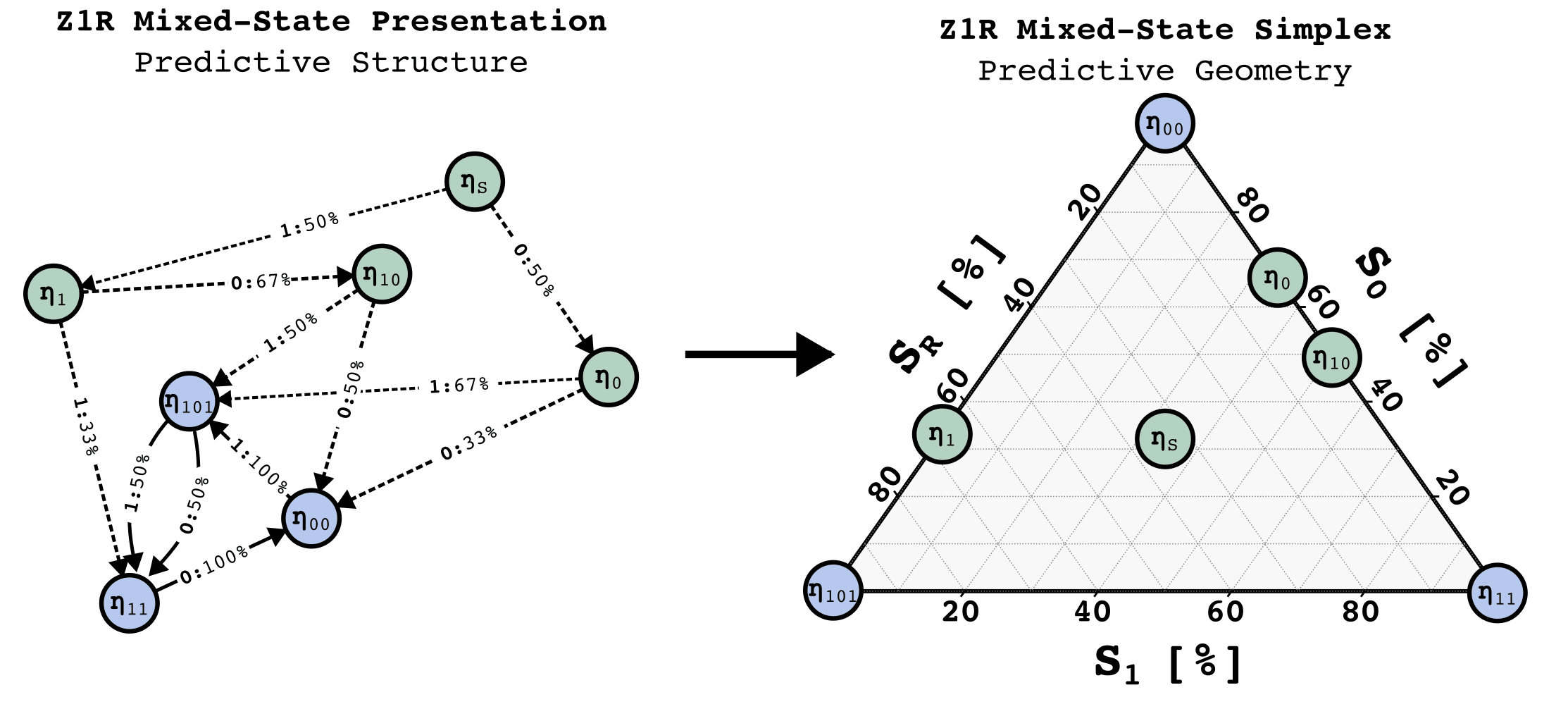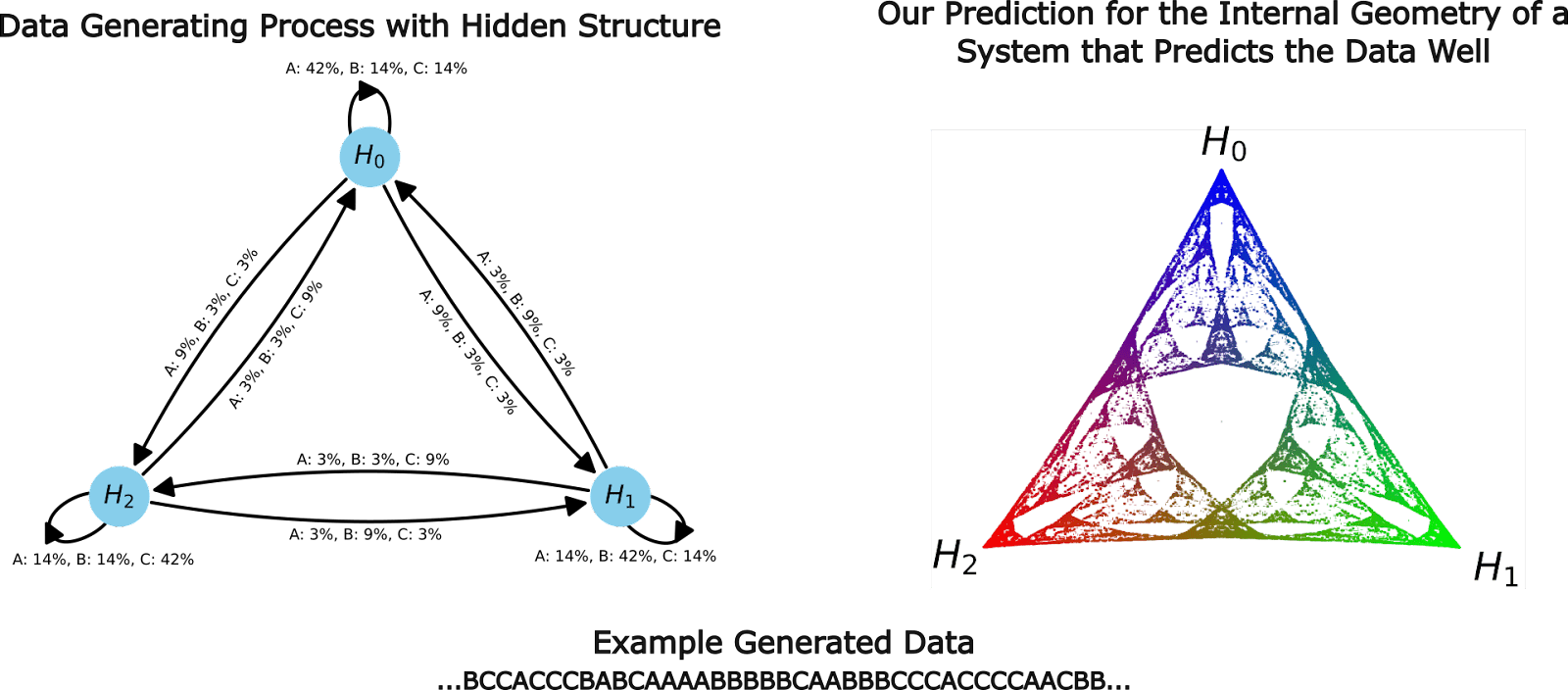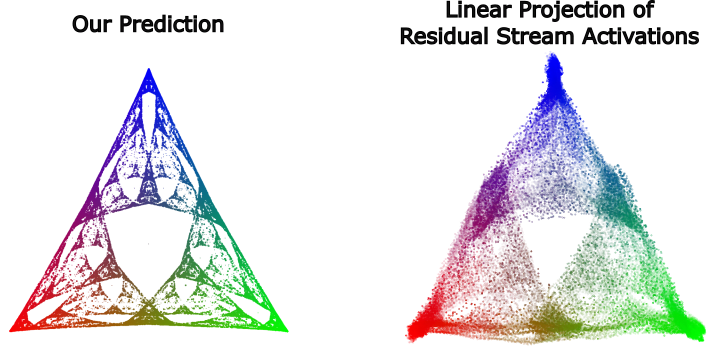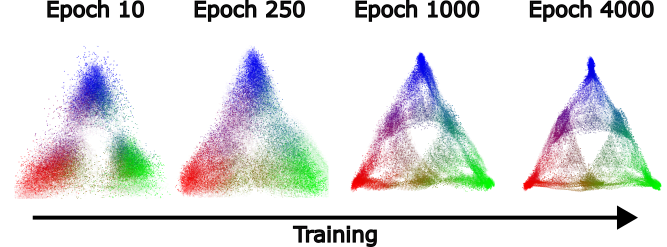Is it accurate to summarize the headline result as follows?
- Train a Transformer to predict next tokens on a distribution generated from an HMM.
- One optimal predictor for this data would be to maintain a belief over which of the three HMM states we are in, and perform Bayesian updating on each new token. That is, it maintains .
- Key result: A linear probe on the residual stream is able to reconstruct .
(I don't know what Computational Mechanics or MSPs are so this could be totally off.)
EDIT: Looks like yes. From this post:
Part of what this all illustrates is that the fractal shape is kinda… baked into any Bayesian-ish system tracking the hidden state of the Markov model. So in some sense, it’s not very surprising to find it linearly embedded in activations of a residual stream; all that really means is that the probabilities for each hidden state are linearly represented in the residual stream.
"The structure of synchronization is, in general, richer than the world model itself. In this sense, LLMs learn more than a world model" given that I expect this is the statement that will catch a lot of people's attention.
Just in case this claim caught anyone else's attention, what they mean by this is that it contains:
• A model of the world
• A model of the agent's process for updating its belief about which state the world is in
We're now working through understanding all the pieces of this, and we've calculated an MSP which doesn't quite look like the one in the post:
(Ignore the skew, David's still fiddling with the projection into 2D. The important noticeable part is the absence of "overlap" between the three copies of the main shape, compared to the fractal from the post.)
Specifically, each point in that visual corresponds to a distribution for some value of the observed symbols . The image itself is of the points on the probability simplex. From looking at a couple of Crutchfield papers, it sounds like that's what the MSP is supposed to be.
The update equations are:
with given by the transition probabilities, given by the observation probabilities, and a normalizer. We generate the image above by running initializing some random distribution , then iterating the equations and plotting each point.
Off the top of your head, any idea what might account for the mismatch (other than a bug in our code, which we're alread...
Everything looks right to me! This is the annoying problem that people forget to write the actual parameters they used in their work (sorry).
Try x=0.05, alpha=0.85. I've edited the footnote with this info as well.
The figures remind me of figures 3 and 4 from Meta-learning of Sequential Strategies, Ortega et al 2019, which also study how autoregressive models (RNNs) infer underlying structure. Could be a good reference to check out!
.
[EDIT: I no longer endorse this response, see thread.]
(This comment is mainly for people other than the authors.)
If your reaction to this post is "hot damn, look at that graph", then I think you should probably dial back your excitement somewhat. IIUC the fractal structure is largely an artifact of how the data is visualized, which means the results visually look more striking than they really are.
It is still a cool piece of work, and the visuals are beautiful. The correct amount of excitement is greater than zero.
To me the consequences of this response were more valuable than the-post-without-this-response, since it led to the clarification by the post's author on a crucial point that wasn't clear in the post and reframed it substantially. And once that clarification arrived, this thread ceased being highly upvoted, which seems the opposite of the right thing to happen.
I no longer endorse this response
(So it's a case where value of content in hindsight disagrees with value of the consequences of its existence. Doesn't even imply there was originally an error, without the benefit of hindsight.)
Can you elaborate on how the fractal is an artifact of how the data is visualized?
From my perspective, the fractal is there because we chose this data generating structure precisely because it has this fractal pattern as it's Mixed State Presentation (ie. we chose it because then the ground truth would be a fractal, which felt like highly nontrivial structure to us, and thus a good falsifiable test that this framework is at all relevant for transformers. Also, yes, it is pretty :) ). The fractal is a natural consequence of that choice of data generating structure - it is what Computational Mechanics says is the geometric structure of synchronization for the HMM. That there is a linear 2d plane in the residual stream that when you project onto it you get that same fractal seems highly non-artifactual, and is what we were testing.
Though it should be said that an HMM with a fractal MSP is a quite generic choice. It's remarkably easy to get such fractal structures. If you randomly chose an HMM from the space of HMMs for a given number of states and vocab size, you will often get synchronizations structures with infinite transient states and fractals.
This isn't a proof of that previous claim, but here are some examples of fractal MSPs from https://arxiv.org/abs/2102.10487:
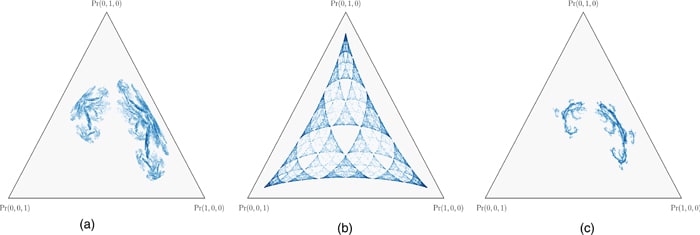
Responding in reverse order:
If there's literally a linear projection of the residual stream into two dimensions which directly produces that fractal, with no further processing/transformation in between "linear projection" and "fractal", then I would change my mind about the fractal structure being mostly an artifact of the visualization method.
There is literally a linear projection (well, we allow a constant offset actually, so affine) of the residual stream into two dimensions which directly produces that fractal. There's no distributions in the middle or anything. I suspect the offset is not necessary but I haven't checked ::adding to to-do list::
edit: the offset isn't necessary. There is literally a linear projection of the residual stream into 2D which directly produces the fractal.
But the "fractal-ness" is mostly an artifact of the MSP as a representation-method IIUC; the stochastic process itself is not especially "naturally fractal".
(As I said I don't know the details of the MSP very well; my intuition here is instead coming from some background knowledge of where fractals which look like those often come from, specifically chaos games.)
I'm not sure I'm following, but...
This is very cool! I’m excited to see where it goes :)
A couple questions (mostly me grappling with what the implications of this work might be):
- Given a dataset of sequences of tokens, how do you find the HMM that could have generated it, and can this be done automatically? Also, is the mapping from dataset to HMM unique?
- This question is possibly more confused on my end, sorry if so. I’m trying to get at something like “how interpretable will these simplexes be with much larger models?” Like, if I’m imagining that each state is a single token, and the HMM is capable of generating the totality of data the model sees, then I’m imagining something quite unwieldy, i.e., something with about the amount of complexity and interpretability as, e.g., the signaling cascade networks in a cell. Is this imagination wrong? Or is it more like, you start with this unwieldy structure (but which has some nice properties nonetheless), and then from there you try to make the initial structure more parse-able? Maybe a more straightforward way to ask: you say you’re interested in formalizing things like situational awareness with these tools—how might that work?
Thanks!
- one way to construct an HMM is by finding all past histories of tokens that condition the future tokens with the same probablity distribution, and make that equivalence class a hidden state in your HMM. Then the conditional distributions determine the arrows coming out of your state and which state you go to next. This is called the "epsilon machine" in Comp Mech, and it is unique. It is one presentation of the data generating process, but in general there are an infinite number of HMM presntations that would generate the same data. The epsilon machine is a particular type of HMM presentation - it is the smallest one where the hidden states are the minimal sufficient statistics for predicting the future based on the past. The epsilon machine is one of the most fundamental things in Comp Mech but I didn't talk about it in this post. In the future we plan to make a more generic Comp Mech primer that will go through these and other concepts.
- The interpretability of these simplexes is an issue that's in my mind a lot these days. The short answer is I'm still wrestling with it. We have a rough experimental plan to go about studying this issue but for now, here are some related que
Promoted to curated: Formalizing what it means for transformers to learn "the underlying world model" when engaging in next-token prediction tasks seems pretty useful, in that it's an abstraction that I see used all the time when discussing risks from models where the vast majority of the compute was spent in pre-training, where the details usually get handwaived. It seems useful to understand what exactly we mean by that in more detail.
I have not done a thorough review of this kind of work, but it seems to me that also others thought the basic ideas in the work hold up, and I thought reading this post gave me crisper abstractions to talk about this kind of stuff in the future.
transformer is only trained explicitly on next token prediction!
I find myself understanding language/multimodal transformer capabilities better when I think about the whole document (up to context length) as a mini-batch for calculating the gradient in transformer (pre-)training, so I imagine it is minimizing the document-global prediction error, it wasn't trained to optimize for just a single-next token accuracy...
There is evidence that transformers are not in fact even implicitly, internally, optimized for reducing global prediction error (except insofar as comp-mech says they must in order to do well on the task they are optimized for).
Do transformers "think ahead" during inference at a given position? It is known transformers prepare information in the hidden states of the forward pass at t that is then used in future forward passes t+τ. We posit two explanations for this phenomenon: pre-caching, in which off-diagonal gradient terms present in training result in the model computing features at t irrelevant to the present inference task but useful for the future, and breadcrumbs, in which features most relevant to time step t are already the same as those that would most benefit inference at time t+τ. We test these hypotheses by training language models without propagating gradients to past timesteps, a scheme we formalize as myopic training. In a synthetic data setting, we find clear evidence for pre-caching. In the autoregressive language modeling setting, our experiments are more suggestive of the breadcrumbs hypothesis.
I think that paper is some evidence that there's typically no huge effect from internal activations being optimized for predicting future tokens (on natural language). But I don't think it's much (if any) evidence that this doesn't happen to some small extent or that it couldn't be a huge effect on certain other natural language tasks.
(In fact, I think the myopia gap is probably the more relevant number than the local myopia bonus, in which case I'd argue the paper actually shows a pretty non-trivial effect, kind of contrary to how the authors interpret it. But I haven't read the paper super closely.)
Also, sounds like you're aware of this, but I'd want to highlight more that the paper does demonstrate internal activations being optimized for predicting future tokens on synthetic data where this is necessary. So, arguably, the main question is to what extent natural language data incentivizes this rather than being specifically about what transformers can/tend to do.
In that sense, thinking of transformer internals as "trying to" minimize the loss on an entire document might be exactly the right intuition empirically (and the question is mainly how different that is from being myopic on a given dataset). Given that the internal states are optimized for this, that would also make sense theoretically IMO.
I have maybe a naive question. What information is needed to find the MSP image within the neural network? Do we have to know the HMM to begin with? Or could it be feasible someday to inspect a neural network, find something that looks like an MSP image, and infer the HMM from it?
I really enjoyed reading this post! It's quite well-written. Thanks for writing it.
The only critique is that I would have appreciated more details on how the linear regression parameters are trained and what exactly the projection is doing. John's thread is a bit clarifying on this.
One question: If you optimize the representation in the residual stream such that it corresponds to a particular chosen belief state, does the transformer than predict the next token as if in that belief state? I.e., does the transformer use the belief state for making predictions?
I struggled with the notation on the figures; this comment tries to clarify a few points for anyone else who may be confused by it.
- There are three main diagrams to pay attention to in order to understand what's going on here:
- The Z1R Process (this is a straightforward Hidden Markov Model diagram, look them up if it's unclear).
- The Z1R Mixed-State Presentation, representing the belief states of a model as it learns the underlying structure.
- The Z1R Mixed-State Simplex. Importantly, unlike the other two this is a graph and spatial placement is meaningful.
- It's b
I'm curious how much space is left after learning the MSP in the network. Does representing the MSP take up the full bandwidth of the model (even if it is represented inefficiently)? Could you maintain performance of the model by subtracting out the contributions of anything else that isn't part of the MSP?
This is a self review. It's been about 600 days since this was posted and I'm still happy and proud about this post. In terms of what I view as the important message to the readership, the main thing is introducing a framework and way of thinking that connects what is a pretty fuzzy notion of "world model" to the concrete internal structure of neural networks. It does this in a way that is both theoretically clear and amenable to experiments. It provides a way to think about representations in transformers in a general sense, that is quite different than t...
This is extremely cool! Can you go into more detail about the step used to project the 64 dimensional residual stream to 3 dimensional space? Did you do a linear fit over a few test points and then used it on all the others?
This is really cool work!!
...In other experiments we've run (not presented here), the MSP is not well-represented in the final layer but is instead spread out amongst earlier layers. We think this occurs because in general there are groups of belief states that are degenerate in the sense that they have the same next-token distribution. In that case, the formalism presented in this post says that even though the distinction between those states must be represented in the transformers internal, the transformer is able to lose those distinctions for the purpose
We do this by performing standard linear regression from the residual stream activations (64 dimensional vectors) to the belief distributions (3 dimensional vectors) which associated with them in the MSP.
I don't understand how we go from this to the fractal. The linear probe gives us a single 2D point for every forward pass of the transformer, correct? How do we get the picture with many points in it? Is it by sampling from the transformer while reading the probe after every token and then putting all the points from that on one graph?
Is this result equiva...
We look in the final layer of the residual stream and find a linear 2D subspace where activations have a structure remarkably similar to that of our predicted fractal. We do this by performing standard linear regression from the residual stream activations (64 dimensional vectors) to the belief distributions (3 dimensional vectors) which associated with them in the MSP.
Naive technical question, but can I ask for a more detailed description of how you go from the activations in the residual stream to the map you have here? Or like, can someone point m...
I thought that the part about models needing to keep track of a more complicated mix-state presentation as opposed to just the world model is one of those technical insights that's blindingly obvious once someone points it out to you (i.e., the best type of insight :)). I love how the post starts out by describing the simple ZIR example to help us get a sense of what these mixed state presentations are like. Bravo!
Non exhaustive list of reasons one could be interested in computational mechanics: https://www.lesswrong.com/posts/GG2NFdgtxxjEssyiE/dalcy-s-shortform?commentId=DdnaLZmJwusPkGn96
This might be an adjacent question but assuming this is true and comprehensively explains the belief updating process. What does it say, if anything, about whether transformers can produce new (undiscovered) knowledge/states? If they can't observe a novel state - something that doesn't exist in the data - can they never discover new knowledge on their own?
Thank you for the insightful post! You mentioned that:
Consider the relation a transformer has to an HMM that produced the data it was trained on. This is general - any dataset consisting of sequences of tokens can be represented as having been generated from an HMM.
and the linear projection consists of:
Linear regression from the residual stream activations (64 dimensional vectors) to the belief distributions (3 dimensional vectors).
Given any natural language dataset, if we didn't have the ground truth belief distribution, is it possible to reverse engineer...
The LessWrong Review runs every year to select the posts that have most stood the test of time. This post is not yet eligible for review, but will be at the end of 2025. The top fifty or so posts are featured prominently on the site throughout the year.
Hopefully, the review is better than karma at judging enduring value. If we have accurate prediction markets on the review results, maybe we can have better incentives on LessWrong today. Will this post make the top fifty?
If I understand this right, you train a transformer on data generated from a hidden markov process, of the form {0,1,R} and find that there is a mechanism for tracking when R occurs in the residual stream, as well as that the transformer learns the hidden markov process. is that correct?
If I understand correctly, the next-token prediction of Mess3 is related to the current-state prediction by a nonsingular linear transformation. So a linear probe showing "the meta-structure of an observer's belief updates over the hidden states of the generating structure" is equivalent to one showing "the structure of the next-token predictions", no?
This reminds me a lot of a toy project I have in the back of my mind but will probably never get around to:
Which is to train a transformer on the sequences generated by the logic models from the apperception engine paper (which in the paper are inferred by the apperception engine from the sequences) with the aim of predicting the logic model.
This is interesting as commentary on superposition, where activation vectors with N dimensions can be used to represent many more concepts, since the N-dimensional space/sphere can be partitioned into many more regions than N, each with its own meaning. If similar fractal structure substantially occurs in the original activation bases (such as the Vs of attention, as in the V part of KV-cache) and not just after having been projected to dramatically fewer dimensions, this gives a story for role of nuance that improves with scale that's different from it be...
Can you help me understand a minor labeling convention that puzzles me? I can see how we can label from the Z1R process as in MSP because we observe 11 to get there, but why is labeled as after observing either 100 or 00, please?
What is the shape predicted by compmech under a generation setting, and do you expect it instead of the fractal shape to show up under, say, a GAN loss? If so, and if their shapes are sufficiently distinct from the controls that are run to make sure the fractals aren't just a visualization artifact, that would be further evidence in favor of the applicability of compmech in this setup.
One nice little prediction from this approach: you'd expect the first few tokens to have denser (as in SAE) features, as there is less context, so the "HMM" could be in a broad range of states. Whereas once you've seen more tokens, you have much more information so the state is pinned down more precisely and you'd expect to be denser.
There's also a big literature from computational neuroscience about how you represent probabilities. This is suggesting a "mean parameter code", where the LLM activations are a function of E[z| data]. But lots of other possibilities are available, e.g. see:
http://www.gatsby.ucl.ac.uk/teaching/courses/tn1-2021/slides/uncert-slides.pdf
Thanks for the post, it's neat to see the fields and terms existing for these questions.
I have two questions for hope of using this type of analysis in my work to analyze a lack of transfer between two distinct datasets A and B. (I see this is in your future work?)
1. Where does OOD data project, or data that is implausible for the model?
2. For more complex data, might we expect this MSP to most clearly show in places other than the final layer?
re: transfer, my hypothesis is that we might be able to see, having trained on A and B, that during inferenc...
This is very interesting work, showing the fractal graph is a good way to visualize the predictive model being learned. I've had many conversations with folks who struggle with the idea 'the model is just predicting the next token, how can it be doing anything interesting'?. My standard response had been that conceptually the transformer model matches up tokens at the first layer (using the key and query vectors), then matches up sentences a few layers up, and then paragraphs a few layers above that; hence the model, when presented with an input, was not j...
We think this occurs because in general there are groups of belief states that are degenerate in the sense that they have the same next-token distribution. In that case, the formalism presented in this post says that even though the distinction between those states must be represented in the transformers internal, the transformer is able to lose those distinctions for the purpose of predicting the next token (in the local sense), which occurs most directly right before the unembedding.
I wonder if you could force the Mixed-State Presentation to be "conse...
Fascinating. But are these diagrams really showing HMMs? I thought each state in an HMM had a set of transition probabilities and another set of emission probabilities, which at each step are sampled independently. In these diagrams, the two processes are coupled. If "Even Ys" were a conventional HMM, would sometimes emit X and transition to , which would result in some even and some odd runs of Y. Are these a special variant of HMM, or some other type of state machine? And would these results apply to conventional HMMs with separate tr...
Nice explanation of MSP and good visuals.
This is surprising!
Were you in fact surprised? If so, why? (This is a straightforward consequence of the good regulator theorem[1].)
In general I'd encourage you to carefully track claims about transformers, HMM-predictors, and LLMs, and to distinguish between trained NNs and the training process. In this writeup, all of these are quite blended.
Is there some theoretical result along the lines of "A sufficiently large transformer can learn any HMM"?
Speaking of next steps, I'd love to see a transformer that was trained to manipulate those states (given target state and interactor's tokens, would emit its own tokens for interleaving)! I believe this would look even cooler, and may be useful in detecting if AI starts to manipulate someone.

